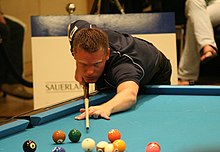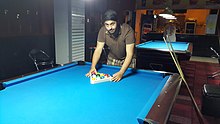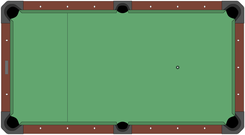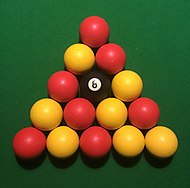Pool (cue sports)


Poolis the name given to a series ofcue sportsplayed on abilliard table.The table has sixpocketsalong therails,into whichballsare shot.[1][2]Of the many different pool games, the most popular include:eight-ball,blackball,nine-ball,ten-ball,seven-ball,straight pool,one-pocket,andbank pool.Eight-ball is the most frequently played discipline of pool, and it is often thought of as synonymous with "pool".[3]
The generic termpocket billiardsis sometimes also used, and favored by some pool-industry bodies, but is technically a broader classification, including games such assnooker,Russian pyramid,andkaisa,which are not referred to as pool games. There are also hybrid games combining aspects of both pool andcarom billiards,such asAmerican four-ball billiards,bottle pool,cowboy pool,andEnglish billiards.
Etymology
[edit]
The etymology of "pool" is uncertain. TheOxford English Dictionaryspeculates that "pool" and other games with collective stakes is derived from the Frenchpoule(literally translated "hen" ), in which thepouleis the collected prize, originating fromjeu de la poule,a game that is thought to have been played during the Middle Ages. Supposedly, participants would put an equal amount of money into a pot and throw stones at a live chicken, and the person who successfully hit the chicken first would win the pooled money.[4][5]Alternatively the term could derive from the verbto poolin the sense of combining objects or stakes. The oldest use of the word "pool" to describe a billiards-like game was made in 1797 in a Virginia newspaper.[6]The OED defines it as generally "any of various types of billiards for two or more players" but goes on to note that the first specific meaning of "a game in which each player uses a cue ball of a distinctive colour to pocket the balls of the other player(s) in a certain order, the winner taking all the stakes submitted at the start of the contest" is now obsolete, and its other specific definitions are all for games that originate in the United States.[7]In theBritish Empirefor most of the nineteenth through early twentieth century,poolreferred specifically to the game oflife pool.[8]: 143&187
Although skittle pool is played on a pocketlesscarom billiardstable, the termpoollater stuck to all new games of pocket billiards as the sport gained in popularity in the United States,[8]: 186 and so outside the cue sports industry, which has long favored the more formal termpocket billiards,the common name for the sport has remainedpool.TheOxfordDictionariesdefinition no longer even provides the obsolete meaning found in the print edition, and refers only to the typical game "using two sets [each] of seven coloured and numbered balls... with one black ball and a white cue ball" on a table with pockets.[9]
History
[edit]With the exception ofone-pocket,games typically called "pool" today are descended from two English games imported to the United States during the 19th century. The first wasEnglish billiardswhich becameAmerican four-ball billiards,essentially the same game but with an extra redobject ballto increase scoring opportunities. It was the most popular billiards game in the mid-19th century until dethroned by the carom gamestraight rail.American four-ball tournaments tried switching to carom tables in the 1870s but this did not save it from being doomed to obscurity; the last professional tournament was held in 1876.[8]: 5–6 Cowboy poolis a surviving member of this group of games.
The second and more influential game waspyramid pool.By 1850 a variant calledfifteen-ball poolbecame popular. Both games were supplanted bycontinuous poolin 1888, the immediate forerunner ofstraight pool(1910).[10]: 39–43 New games introduced at the turn of the 20th century includeKelly poolandeight-ball.The distinctive appearance of pool balls with their many colors and division between solid and striped balls came about by 1889.[8]: 246 Prior to this, object balls were uniformly deep-red and differentiated only by numbers. English pyramid pool andlife poolplayers were the first to adopt balls with different colors. The stripes were the last addition.[10]: 90–91
Equipment
[edit]
Pool is played on asix pocket table.Modern pool tables generally range in size from 3.5 by 7 feet (1.07 by 2.13 m), to 4.5 by 9 feet (1.37 by 2.74 m).
UnderWorld Pool-Billiard Association(WPA) official equipment specifications,pool ballsweigh from 5.5 to 6 oz (160 to 170 g) and have a diameter of 2.25 inches (57 mm), plus or minus 0.005 inches (0.13 mm).[11][12]Modern coin-operated pool tables generally use one of three methods to distinguish and return the cue ball to the front of the table while the numbered balls return to an inaccessible receptacle until paid for again: the cue ball is larger and heavier than the other balls, or denser and heavier, or has a magnetic core.
Moderncue sticksare generally 58.5 inches (148.6 cm) long for pool while cues prior to 1980 were designed for straight pool and had an average length of 57.5 inches (146.1 cm). By comparison, carom billiards cues are generally shorter with larger tips, and snooker cues longer with smaller tips.
Game types
[edit]Racked games
[edit]These are games descended from the early 19th century games ofpyramid poolandfifteen-ball poolwhich required balls to berackeddue to the large number of them on the table. Of the other pyramid traditions of Continental Europe, onlyRussian pyramidsurvives.Snooker,originally known as snooker's pool, can be considered a member of this family.
Rotation games
[edit]
Rotation games require players to make legal contact with the lowest numbered ball on the table or a foul is called. The earliest rotation game, originally known as61,started off as a variant offifteen-ball poolduring the mid-nineteenth century. The name "rotation" came from how the balls were placed around the table in its unracked offshootChicago.61 has spawned many variations of its own such asAmerican rotation,nine-ball,ten-ball,andKelly pool.Of these, nine-ball is the most popular and the predominant professional game with ten-ball as the second-most prominent.[13][clarification needed]There are many local and regional tours and tournaments that are contested with nine-ball. TheWorld Pool-Billiard Association(WPA) publishes the world standardized rules. The European professional circuit has instituted rules changes to make it more difficult to achieve a legal break shot.[13][14]
The largest nine-ball tournaments are theUS Open Nine-ball Championshipand theWPA World Nine-ball Championshipfor men and women. A hotly contested event is the annualMosconi Cup,which pits invitational European and U.S. teams against each other in one-on-one andscotch doublesnine-ball matches over a period of several days. The Mosconi Cup games are played under the more stringent European rules, as of 2007.[14]
Straight pool
[edit]Also known as14.1 continuous,this game originated as a slight modification ofcontinuous pool,another offshoot of fifteen-ball pool. The shooter may attempt to shoot at any object ball on the table. The goal is to reach a set number of points determined by agreement before the game. One point is scored for each object ball pocketed where nofoulis made. A typical game might require a player to score 100 points to win. In professional competition, straight pool is usually played to 125 points. Straight pool is acall-pocketgame, meaning the player must indicate the intended object ball and pocket on every shot.
Eight-ball
[edit]The most commonly played pool game is eight-ball, which appeared at the beginning of the twentieth century. It is often thought of as synonymous with "pool". The game has numerous variations, mostly regional. It is the second most played professional pool game, afternine-ball,and for the last several decades ahead ofstraight pool.[3]
The goal of eight-ball, which is played with a full rack of fifteen balls and the cue ball, is to claim a suit (commonly stripes or solids in the US, and reds or yellows in the UK), pocket all of them, then legally pocket the 8 ball, while denying one's opponent opportunities to do the same with their suit, and without sinking the 8 ball early by accident. In the United Kingdom the game is commonly played in pubs, and it is competitively played in leagues on both sides of the Atlantic. The most prestigious tournaments including the World Open are sponsored and sanctioned by the International Pool Tour. Rules vary widely from place to place (and between continents to such an extent that British-styleeight-ball pool/blackballis properly regarded as a separate game in its own right). Pool halls in North America are increasingly settling upon theWorld Pool-Billiard AssociationInternational Standardized Rules. But tavern eight-ball (also known as "bar pool"), typically played on smaller, coin-operated tables and in a" winner keeps the table "manner, can differ significantly even between two venues in the same city. The growth of local, regional and national amateur leagues may alleviate this confusion eventually.
One-pocket
[edit]One-pocket owes its origins to 18th centurycramp(handicapped) games. It is a strategic game for two players in which each player is assigned one of the corner pockets on the table. This is the only pocket into which that player can legally pocket balls. The first player to pocket the majority of the balls (8) into their pocket wins the game. The game requires far more defensive strategy than offensive strategy, much unlike eight-ball, nine-ball, or straight pool. Most times, accomplished players choose to position balls near their pocket instead of trying to actually pocket them. This allows them to control the game by forcing their opponent to be on defense instead of taking a low percentage shot that could result in a loss of game. These low percentage shots are known as "flyers" by one-pocket aficionados.
Bank pool
[edit]Bank pool can be played with a full rack (can be alonggame), but is more typically played with nine balls (frequently called "nine-ball bank" ). The balls are racked in nine-ball formation, but in no particular order. The object of the game is simple: to be the first player to bank five balls in any order (eight balls when played with a full rack). Penalties and fouls are similar to one pocket in that the player committing the foul must spot a ball for each foul. This must be done before the incoming player shoots.
Artistic pool
[edit]Artistic pool is the competitive discipline oftrick shotsinspired by itscarom equivalent.Played on pool or snooker tables, players must complete a set number of shots of varying difficulty.
Hybrid carom or obstacle games
[edit]Cowboy poolandbottle poolare games involving only a few balls which are placed at specific spots on the table. Elements of their games go back to the eighteenth century before balls needed to be racked. Bottle pool shares traits withpin billiardsgames such asDanish pin billiards.Cowboy pool is a descendant ofEnglish billiards.Kaisais a similar game played with different equipment.
Governing bodies
[edit]As a competitive sport, pool is governed internationally by theWorld Pool-Billiard Association(WPA), which has multi-national, regional affiliates comprising the All Africa Pool Association (AAPA), Asian Pocket Billiard Union (APBU, including the Middle East),Billiard Congress of America(BCA, Canada and the US),Confederación Panamericana de Billar(CPB, Latin America and Caribbean),European Pocket Billiard Federation(EPBF, including Russia and the Near East), and Oceania Pocket Billiard Association (OPBA, Australia, New Zealand, Pacific islands). The WPA represents pool in theWorld Confederation of Billiards Sports,which in turn represents all forms ofcue sports(includingcarom billiardsandsnooker) in theInternational Olympic Committee.
Notes
[edit]- ^"The Official Website for the Governing Body of Pool".WPA-Pool.Sydney, Australia:World Pool-Billiard Association(WPA). 2011. banner, copyright notice, etc.Archivedfrom the original on 11 October 2007.Retrieved4 November2011."Pool billiards" is sometimes hyphenated and/or spelled with a singular "billiard". The WPA itself uses "pool-billiard" in its logo but "pool-billiards" in its legal notices. The organization compounds the words to result in an acronym of "WPA", "WPBA" having already been taken by theWomen's Professional Billiards Association.Normal English grammar would not hyphenate here, andthe term is actually a Germanism.
- ^Game Rules for… Six-pocket.Amityville, New York: U.S. Billiards, Inc. c. 1970.A general rules booklet on pool games in general, including eight-ball, nine-ball and several others.
- ^ab"History of Snooker and Pool".Sky HISTORY TV channel.Archivedfrom the original on 24 July 2021.Retrieved6 April2022.
- ^"pool | Etymology, origin and meaning of pool by etymonline".etymonline.Archivedfrom the original on 7 April 2023.Retrieved7 April2023.
- ^Forsyth, Mark (2012).The etymologicon: a circular stroll through the hidden connections of the English language(Berkley trade pbk. ed.). New York:Berkley Books.ISBN978-0-425-26079-1.OCLC775418832.
- ^"entry for Pool, n.3".Oxford English Dictionary.Archivedfrom the original on 11 January 2008.Retrieved15 February2018.
- ^"pool, n., 3.2".Oxford English Dictionary(Third ed.).Oxford University Press.September 2011 [2006].Archivedfrom the original on 22 April 2024.Retrieved30 September2011– via OED.(subscription required)
- ^abcdShamos, Mike(1999).The New Illustrated Encyclopedia of Billiards.New York: Lyons Press.ISBN9781558217973– via Internet Archive.
- ^"pool, 2, noun, 2".OxfordDictionaries.British and World English. Oxford University Press. 2016. Archived fromthe originalon 24 July 2012.Retrieved15 July2016.
- ^abShamos, Mike (1994).Pool.New York City:Friedman/Fairfax.ISBN9781567990614.
- ^"WPA Tournament Table & Equipment Specifications"Archived18 February 2011 at theWayback Machine,World Pool-Billiard Association,November 2001.
- ^BCA Rules Committee (2004).Billiards: The Official Rules and Records Book.Colorado Springs, Colorado:Billiard Congress of America.p. 5.ISBN978-1-878493-14-9.
- ^abVarner, Nick (February 2008). "Killing Me Softly? The Outbreak of the Soft Break Threatens the Game of 9-ball".Billiards Digest.Vol. 30, no. 3. Chicago: Luby Publishing. pp. 4–35.ISSN0164-761X.
- ^abPanozzo, Mike (February 2008). "Long Live the Cup!".Billiards Digest.Vol. 30, no. 3. Chicago: Luby Publishing. pp. 34–35.ISSN0164-761X.
References
[edit]- Shamos, Mike(1999).The New Illustrated Encyclopedia of Billiards.New York: Lyons Press.ISBN9781558217973– via Internet Archive.
- Byrne, Robert(1978),Byrne's Standard Book of Pool and Billiards,New York andLondon:Harcourt Brace Jovanovich,ISBN0-15-115223-3
Further reading
[edit]- Alciatore, David G. (2017).The Illustrated Principles of Pool and Billiards(ebook).Union Square & Company.ISBN9781454927914.
- Alciatore, David G. (May 2017).The Sport of Pool Billiards 1: Techniques and Training Based on PAT Part 1(ebook).Union Square & Company.ISBN9781454927914.
- Byrne, Robert(1998).Byrne's New Standard Book of Pool and Billiards(Paperback).Harcourt Brace & Company.ISBN9780156005548.
- Eckert, Ralph (8 May 2015).The Sport of Pool Billiards 1: Techniques and Training Based on PAT Part 1(ebook).Litho.ISBN9783941484986.
{{cite book}}:CS1 maint: date and year (link) - Leider, Nicholas (12 February 2010).Pool and Billiards For Dummies(ebook).For Dummies.Wiley.ISBN9780470633946.
{{cite book}}:CS1 maint: date and year (link)



